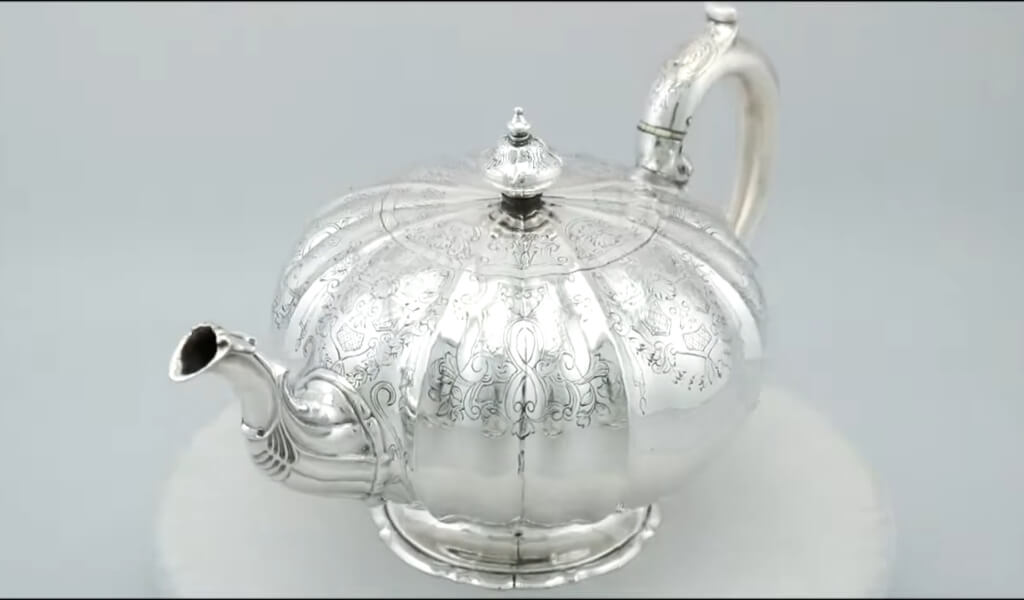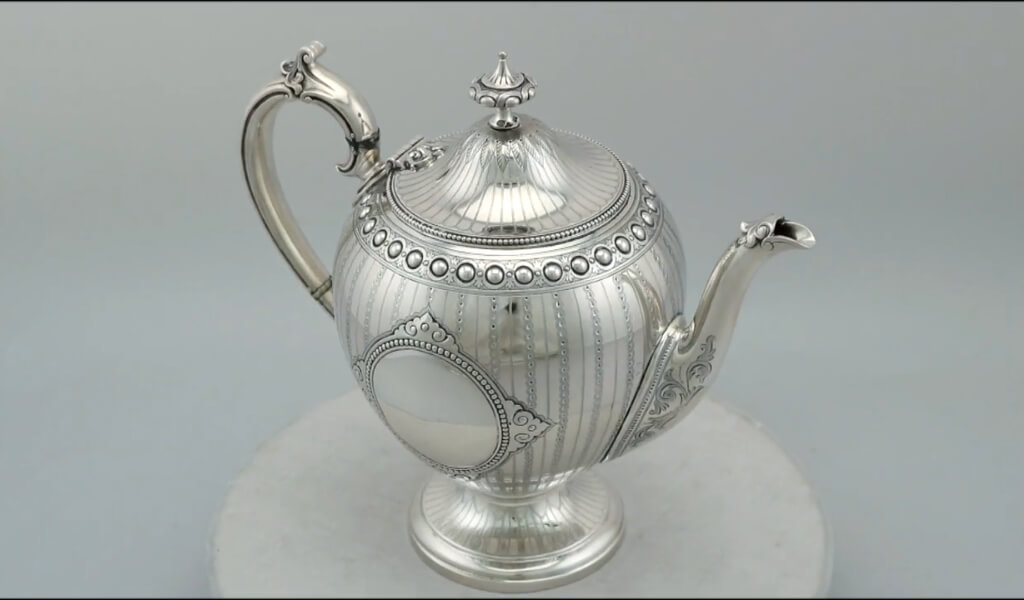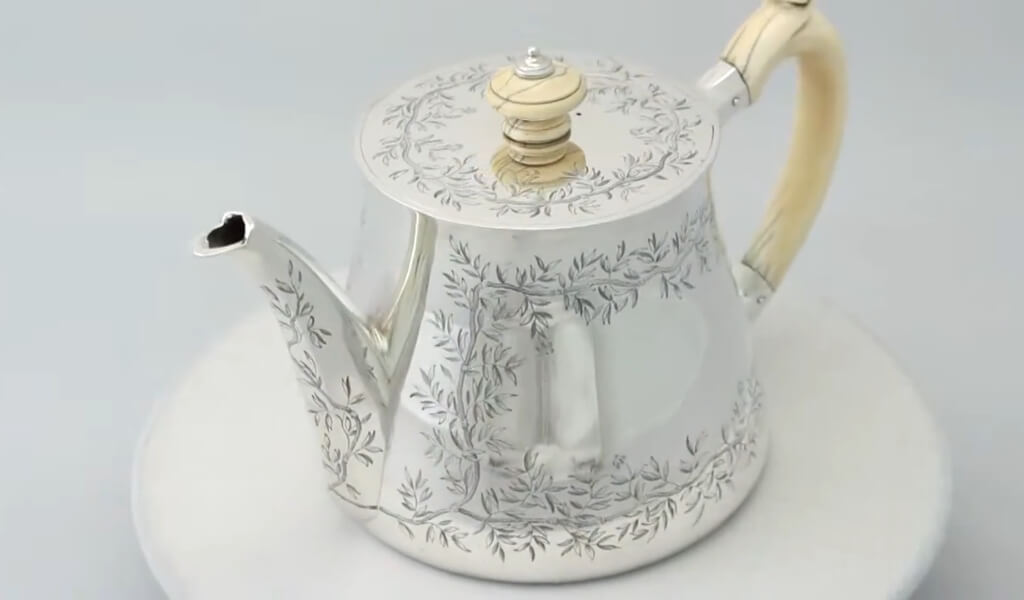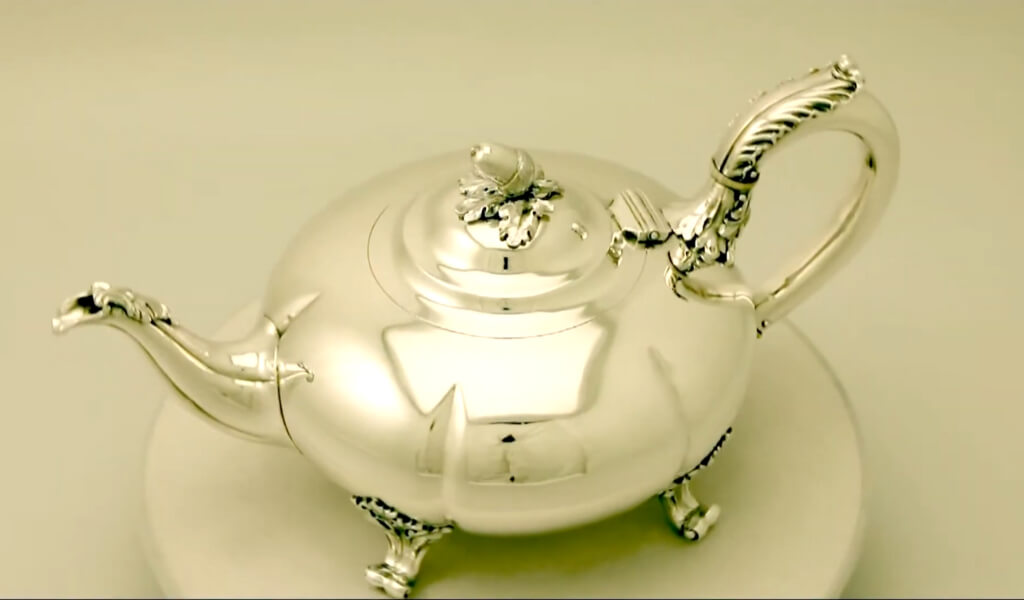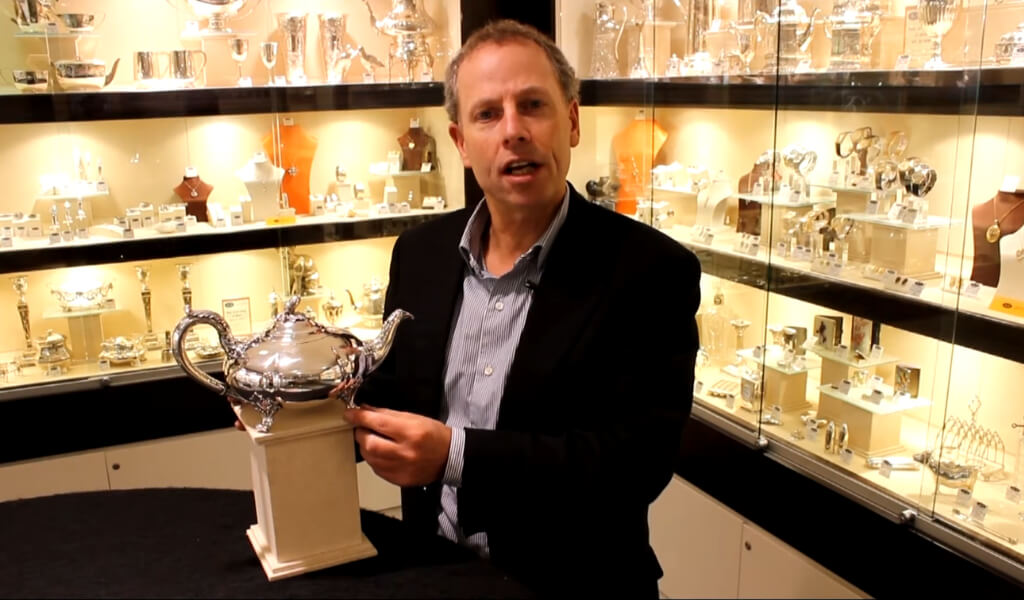Hi everyone! Did you know that, according to Statista, as of 2020, over 159 million Americans drink tea on any given day? That’s a lot of tea!
Today I want to talk about one of my favorite things – a Silver Teapot. You know, a special charm comes with a Silver Teapot. It’s shiny and elegant and makes drinking tea feel more special.
But owning a Silver Teapot is not just about enjoying a nice cup of tea. It’s also about knowing how to use a sterling silver teapot properly.
Over the years, I’ve learned a few tips and tricks about using and maintaining a Silver Teapot, and I’m here to share those with you. Whether you already have a Silver Teapot, are thinking of getting one, or are just interested in learning more about them, this is for you.
Let’s get started!
Maybe you are interested: Top 8 Best Teapots 2023 – Actual Tests And Detailed Reviews
The Silver Teapots Origin & History
Silver teapots first came into the picture in the 18th century. They were introduced in England after tea was imported from China, and soon they became a big hit.
Initially, Silver Teapots were small because tea was very expensive back then. But as tea became more affordable and more popular, the teapots grew in size to accommodate the increased consumption. Over time, the designs also evolved from simple to highly decorative, reflecting the styles and trends of each era.
When we talk about traditional Silver Teapots, we refer to those made during the early days of Silver Teapot making. They often have simple shapes and designs, mirroring the aesthetics of their time.
On the other hand, Victorian Silver Teapots were made during Queen Victoria’s reign, a period known for its elaborate and intricate designs. These teapots often feature ornate decorations, intricate carvings, and a generally heavier look than their earlier counterparts.
Using a Sterling Silver Teapot
Last week, I had the pleasure of hosting a small tea party at my place. The star of the show was my trusted sterling Silver Teapot. Brewing tea in a Silver Teapot is a unique experience, and I can’t wait to share with you how to use it.
Step-by-step Guide
1. Preheat Your Teapot
Start by warming your teapot. Simply pour boiling water into the teapot, swirl it around, then pour it out. This step helps maintain the tea’s temperature once it’s brewed.
2. Measure Your Tea
Next, add your tea. The general rule of thumb is one teaspoon per cup and one for the pot. But feel free to adjust according to your taste.
3. Add Hot Water
Pour hot water into the teapot. Be sure to use the right temperature for your type of tea. For example, black tea needs boiling water, while green tea prefers slightly cooler water.
4. Steep
Let the tea steep. This is when the tea leaves infuse their flavor into the water. The steeping time varies depending on the type of tea. Typically, it’s around 2-3 minutes for green tea, and 4-5 minutes for black tea.
5. Pour
Once your tea is steeped, it’s time to pour. Use a tea strainer if needed, and remember to hold the lid as you pour to prevent it from falling off.
Tips & Tricks for the Best Tea Using a Sterling Silver Teapot
Using a sterling Silver Teapot is about more than just following steps. Here are a few tips to make the best cup of tea:
- Never Overfill: To allow the tea leaves to unfurl and release their flavors fully, only fill your teapot up to two-thirds.
- Clean Properly: After each use, rinse your teapot with warm water and dry it thoroughly to prevent tarnishing.
- Use Quality Water: Water quality can greatly affect your tea’s taste. Always use fresh, filtered water if possible.
Now you’re ready to enjoy a perfect cup of tea from your sterling Silver Teapot. Trust me, once you’ve tasted tea from a silver teapot, there’s no going back!
Read More: Here is My ultimate guide on Type Of Teapot
How to clean and maintain your Silver Teapot
Owning a Silver Teapot means you’ll need to give it a bit of TLC to keep it looking its best. Here’s how to take care of your silver teapot daily and when it needs extra cleaning.
Daily Cleaning Routine
Keeping your Silver Teapot clean after each use helps prolong its life and keeps your tea tasting great. Here’s what I recommend:
- Empty It Out: After each use, empty your teapot completely. Don’t let tea leaves or leftover tea sit in the teapot for too long, as they can stain the interior.
- Rinse Well: Rinse your teapot thoroughly with warm water. Avoid using detergents as they can leave a residue and affect the taste of your tea.
- Dry Properly: Dry your teapot immediately after rinsing. Use a soft, dry cloth to wipe it inside and out. This helps prevent water spots and tarnishes.
Cleaning Methods for your Silver Teapot shine
Despite your best efforts, your Silver Teapot might lose its shine over time. When that happens, it’s time for a deep clean. Here’s a simple method that I’ve found effective:
- Prepare a Bath: Fill a large bowl to submerge your teapot with warm water. Add a tablespoon of baking soda for every cup of water.
- Soak: Submerge your teapot in the water and baking soda mixture. Make sure it’s completely covered. Let it soak for a few hours or even overnight for stubborn tarnish.
- Scrub Gently: Use a soft cloth or sponge to gently clean the teapot after soaking. Be careful not to scrub too hard, as you might scratch the surface.
- Rinse and Dry: Rinse the teapot thoroughly with warm water to remove all baking soda residue. Then, dry it immediately with a soft, dry cloth.
And there you have it – a sparkling Silver Teapot, ready to brew the perfect cup of tea! Regular care and timely deep cleaning will ensure your Silver Teapot continues to serve you well for years.
Read More:
- How Much Tea to Use for the Perfect Strength
- How to clean a cast iron teapot
- How to Use a Ceramic Teapot? Detailed Guide With Step By Step
- How To Use A Porcelain Teapot? Ultimate Guide & Tips To Follow
- How To Clean Stainless Steel Tea Kettle? Ultimate Guide With 5 Steps
What is a High-Quality Silver Teapot
How do you recognize a high-quality silver teapot?
In 2019, I recall a memorable afternoon at a bustling London flea market. I spotted a delightful Silver Teapot that piqued my interest. To identify top-notch Silver Teapots, I focus on three key factors.
Firstly, weight matters. Quality teapots have a substantial feel, balanced when held, avoiding a too-light sensation. Secondly, craftsmanship is crucial. Look for intricate details, smooth edges, and a snug lid as signs of excellent workmanship. Lastly, the sound test. Gently tapping it should produce a clear, ringing sound, not a dull thud.
The teapot at that London market ticked all the right boxes, but I had to check one more crucial element – the hallmark. Hallmarks on a Silver Teapot serve as an assurance of its silver content and quality. They provide information about the manufacturer, the year it was made, and sometimes even the city it came from.
On closer inspection, I found the hallmark on the bottom of the teapot, indicating it was made of sterling silver by a well-known silversmith in the late 1800s. That was the moment I knew I’d found a real gem.
Recognizing a high-quality silver teapot isn’t just about ensuring your investment, it’s also about appreciating the skill and artistry of creating these beautiful pieces. So next time you come across a Silver Teapot, remember to look a little closer. You never know what treasures you might find!
How to buy a Silver Teapot
If you’re in the market for a Silver Teapot, there are a few things to remember. Buying a Silver Teapot is more complex than picking the prettiest one. You must consider several factors to ensure you’re getting your money’s worth.
Expect Your Purpose
Before you start your search, it’s important to think about what you want from your Silver Teapot. Are you looking for something practical for daily use, a decorative item for your collection, or perhaps a valuable antique for investment? Your purpose will help guide your choice.
Consider the Silver Teapot Quality
Quality is a crucial factor when buying a Silver Teapot. As I mentioned earlier, you should consider the teapot’s weight, craftsmanship, and sound, and of course, remember to check for the hallmark. These elements give you an idea of the teapot’s authenticity and overall quality.
Determining the Silver Teapot Value
The value of a Silver Teapot depends on various factors, including its age, maker, condition, and rarity. Antique Silver Teapots made by renowned silversmiths, especially those in excellent condition or featuring unique designs, tend to be more valuable.
The True Value of a Silver Teapot
However, it’s important to remember that value isn’t just about the price tag. The real value of a silver teapot also lies in the enjoyment it brings you. Whether that’s the satisfaction of brewing a perfect cup of tea or the delight of owning a piece of history, the true value of a Silver Teapot is in the eyes of the beholder.
So, when you’re out looking to buy a Silver Teapot, don’t rush. Take your time, research, ask lots of questions, and most importantly, choose a teapot you truly love. After all, buying a silver teapot isn’t just about the purchase; it’s about starting a journey rich with history and culture. Enjoy your teapot hunting!
Conclusion
In My exploration of silver teapots, we’ve seen their rich history and learned how to identify quality pieces. Buying a teapot requires thought, but with the tips provided, it’s a task anyone can accomplish.
Using a sterling silver teapot transforms tea brewing into an art, enhancing the whole experience. Regular maintenance and cleaning keep your teapot in good shape, ensuring a long life of great tea sessions.
Owning and using a silver teapot is a blend of elegance and tradition. Whether you collect or love tea, this timeless item elevates your daily routine. Brewing tea isn’t just a chore; it’s a delightful journey. Savor every moment.
Thanks from spiriteadrinks.com
FAQs
Can you boil water in a silver teapot?
While you can technically boil water in a high-quality silver teapot, it’s generally not recommended. Excessive heat can cause the silver to tarnish more quickly and potentially warp or damage the teapot’s shape. It’s better to boil water in a kettle and transfer it to your silver teapot for steeping.
Is it safe to use a silver teapot?
Using a traditional silver teapot for brewing and serving tea is safe. Silver doesn’t react with tea or water at the temperatures typically used for brewing, so you don’t have to worry about harmful substances leaching into your drink.
Does hot water affect silver?
Hot water alone doesn’t damage silver. However, sudden temperature changes can cause silver to expand and contract, leading to cracking or distortion over time. So, while using hot water is essential for brewing tea in your silver teapot, avoid drastic temperature shifts.
Does tap water damage silver?
Tap water won’t necessarily damage silver, but it can contribute to tarnishing, especially if it’s hard water with high mineral content. Therefore, using filtered water can be a better option when brewing tea in your silver kettle.
Does salt water ruin sterling silver?
Yes, salt water can tarnish sterling silver. Over time, exposure to salt water can cause the silver to corrode, leading to a dull, blackish coating on the surface. If your silver teapot comes into contact with salt, it’s best to rinse it thoroughly as soon as possible.
How long does sterling silver last?
With proper care, sterling silver can last a lifetime. This durable material can withstand years of use, and its natural tarnish can be easily cleaned, helping to keep your sterling silver teapot looking beautiful for generations.
Is sterling silver real silver?
Yes, sterling silver is real silver. It’s an alloy of 92.5% silver and 7.5% other metals, usually copper, for added durability. The high silver content preserves the precious metal’s beauty while making it more practical for teapot items.
How can you tell real sterling silver from fake?
Authentic sterling silver usually bears a hallmark or stamp indicating its purity (like “925” or “Sterling”). You can also perform a magnet test, as silver is not magnetic. However, the most reliable method is to take the piece to a professional jeweler or antique dealer for evaluation.
Does tea taste better from a silver teapot?
Many tea enthusiasts believe that tea tastes better from a silver teapot. Silver is an excellent conductor of heat, providing an even and consistent brewing process. This can help fully develop the tea’s flavors, potentially enhancing its taste.
What type of tea is best to brew in a silver teapot?
Any type of tea can be brewed in a sterling silver teapot. However, many tea connoisseurs prefer brewing high-quality loose-leaf teas in silver teapots to fully appreciate the nuanced flavors and aromas that the heat conduction of the silver can enhance.
Does a silver teapot need to be polished regularly?
While regular polishing can maintain the shine of your antique silver teapot, it can be optional. Tarnish does not affect the teapot’s performance. If you prefer the shiny look, you can polish it with a gentle silver polish following the manufacturer’s instructions.
What should I do if my silver teapot gets a dent?
If your vintage silver teapot gets a dent, it’s best to take it to a professional for repair. Trying to fix it yourself can cause more damage. Professionals have the tools and expertise to restore your teapot to its original condition.
Can I use a dishwasher to clean my silver teapot?
It’s not recommended to clean your silver tea set in a dishwasher. The heat and harsh detergents can cause damage and tarnishing. It’s best to gently hand wash your silver teapot with warm water and mild soap and then dry it thoroughly.
I’m Shanna, creator of Spiritea Drinks. I’m all about teaching people to grow their own food, tea, cook what they harvest, and eat with the seasons.

